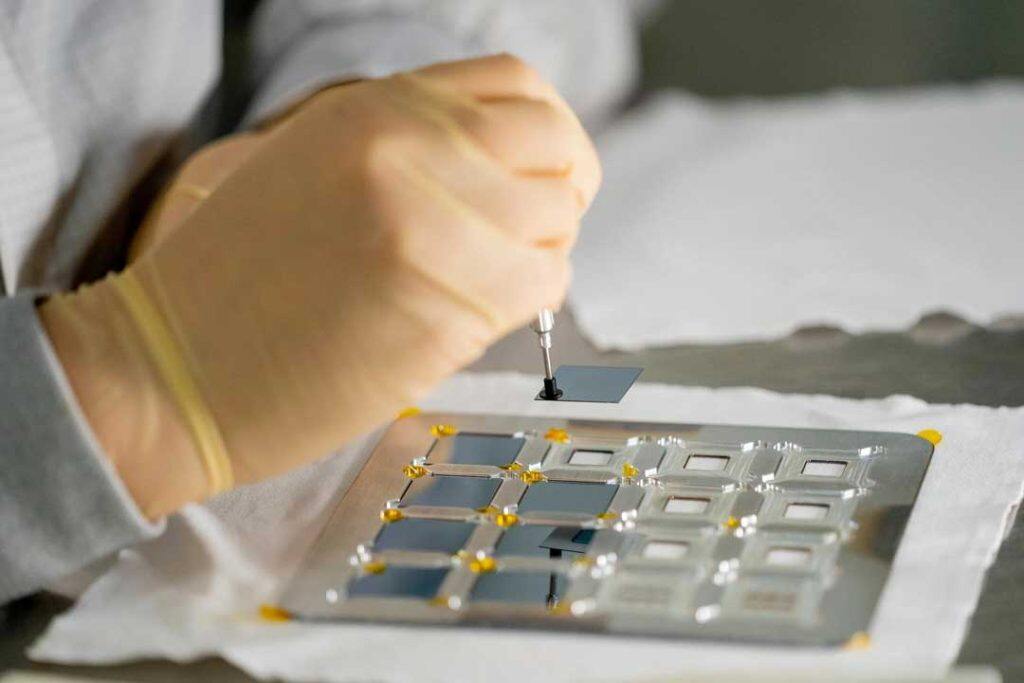

The microelectronics industry is booming in Arizona, with thousands of jobs that need to be filled.
Arizona State University has created a one-stop shop for people who are interested in training for a career in microelectronics, whether it’s in the gigantic new Taiwan Semiconductor Manufacturing Company facility being built in northwest Phoenix or one of the hundreds of supporting supplier companies across the Valley.
The Microelectronics Workforce Development Hub lists more than 70 courses available to people across the life span — high school students, college-goers and workers who would like retrain for a new career. Many more courses will be added next year.
Sally Morton, executive vice president of ASU’s Knowledge Enterprise, said that filling those jobs is critical to the national goal of stepping up semiconductor manufacturing in the U.S.
“We’re trying to meet that need because that’s what ASU does. We do a lot of research, but our single most important product is our students. We mean that very broadly — education across the life span,” she said.
The Microelectronics Workforce Development Hub not only serves people seeking an engineering degree, but also those who are looking to become a technician or other manufacturing role.
“Maybe there’s a person who would like to get into the semiconductor industry to raise the economic level of his or her family. How do they learn a few things that will make them more competitive for these higher-paid jobs?” Morton said.
“Arizona State University is meeting this moment of national focus in semiconductor manufacturing and research to partner with industry and provide innovative learning tools and career paths for people to take advantage of as they seek new opportunities for a career in this dynamic field where job growth is expanding at an unprecedented rate,” ASU President Michael Crow said.
“We have launched ASU Microelectronics Workforce Development Hub to help make connections, provide resources and advance the industry at a time where expanding semiconductor manufacturing capacity is both a strategic national priority and an economic opportunity for the state of Arizona,” he said.
The offerings range from one course to full degrees. Courses can be “stacked” to acquire a professional credential. For example, a certificate in battery technologies includes four courses totaling 50 hours. Professional industry certifications, such as engineering project management and Lean Six Sigma Green Belt (Manufacturing), also are offered.
The hub is an important tool because ASU is large and complex, according to Grace O’Sullivan, vice president of corporate engagement and strategic partnerships at ASU.
“Part of our inclusion and access mission is how to access ASU, so having a single portal will really help ensure that people can find this easy to navigate,” she said.
The hub was created with feedback from industry partners, including those who serve on ASU’s Microelectronics Industry Council as well as SEMI, an industry association.
“We had meetings and interviews, and they brought in their human resources specialists to give us all kinds of feedback on the design and who they’re looking to hire,” O’Sullivan said.
ASU’s offerings on the hub will continue to expand with that input.
“They would like to work with us to connect directly to open positions,” she said, adding that ASU also plans to partner with companies to upskill their employees.
“And we’d like to enhance the website to really show what a day in the life of a semiconductor technician or engineer is.”
The hub will also eventually offer hands-on training, which is critical in this field, according to Binil Starly, professor and director of the School of Manufacturing Systems and Networks at ASU.
“You cannot teach microelectronics through purely online classes,” he said.
“You cannot get away from the fact that you have to touch a robot or work in a clean fab.”
The ASU School of Manufacturing Systems and Networks has been piloting a two-day, 10-hour introductory course for anyone with a high school diploma on “Robotics in Microelectronics Manufacturing.” The course, which may be scaled up next year, covers what a clean-room technician who oversees industrial robots should know.
“We let them play with the robotics and handle wafers, and we make them wear a bunny suit because that’s how they would be operating in a clean room,” Starly said.
“These things matter because then they see themselves in the industry.”
Starly said ASU may investigate using extended-reality modalities in some courses to demonstrate the hands-on skills needed.
“You see this application with pilots who train in flight simulators before sitting in an actual plane,” he said.
“Stacking” these kinds of courses together into credentials also makes sense, he said.
“Students want to pick up skills through workshops or short courses, but oftentimes we see a sporadic mix of short courses that don’t lead to anything meaningful, so we’re trying to create a pathway to take bite-sized content that leads to something meaningful,” he said.
O’Sullivan said that some of the industry partners have committed to opening their facilities for hands-on workforce training.
“That’s where we see this growing,” she said.
“The approach we’re taking is to be ultra-responsive to industry.”
Learn more at microelectronics.asu.edu/workforce-development.
Top image of the ASU MacroTechnology Works facility in Tempe by Samantha Chow/ASU News



































